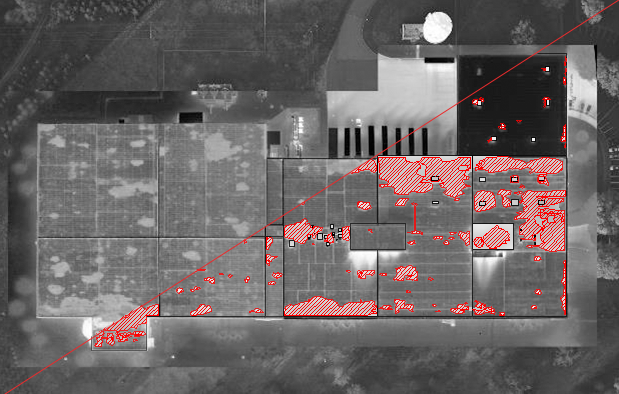How can Infrared Roof Leak Surveys help?
Aerial infrared roof leak surveys provide a comprehensive and cost-effective way to accurately detect roof moisture issues before they become a serious problem. The biggest advantage of aerial infrared comes from the ease of scanning a variety of roofs that would otherwise be difficult to image.
With the high-resolution ‘plan view’ of aerial imagery, slight nuances of temperature can be seen from far enough away to see a pattern of heat and pinpoint the exact location of issues.
Advantages of Aerial IR Roof Surveys
- Know the condition of your roofs quickly, allowing for better preventative maintenance, warranty enforcement, and budget planning.
- Capture large areas at once, making imagery easier to analyze and the report clear and concise.
- Detailed reports are less expensive to produce because infrared images, visual images and AutoCAD® drawings are reconciled.
- Plan view imaging allows for accurate marking of areas of suspect roof moisture contamination.
- On-roof IR survey problems eliminated (logistical, image quality, access and security problems).
How does it work?
Roof moisture survey reports are made by capturing IR and visual images and making scaled drawings of the wet areas, so that surgical repairs can be accomplished.

Almost all roof insulation materials discarded in the US annually are dry. Why throw away 95% of the insulation when it is not damaged? With a thermal map of a group of buildings one can narrow down the roofs that have problems from the ones that do not…on a wholesale basis. This allows facilities management to concentrate on those roofs that need to be repaired, while keeping a trend-quality image of the good roofs.
Subsurface wet areas in a flat or low-sloped roof show up as lighter areas in the IR imagery at night because the latent heat (from daytime heating) in the trapped water mass is greater than in the dry, functioning insulation or roof substrate. Areas of roof moisture contamination can be nebulous in shape and sometimes mottled in appearance, although they are commonly found in linear or puddle-like shapes.
The linear shapes many times follow low areas, drainage routes, roof edges and seams. Puddle-like round or oblong shapes often form around roof penetrations such as mechanical equipment, standpipes, vents and drains. After sunset when the entire roof structure cools down, wet areas of roof insulation and other materials continue to radiate heat because of their higher mass.